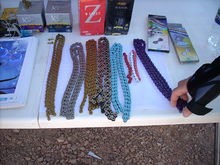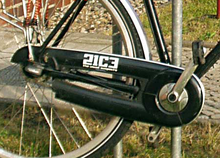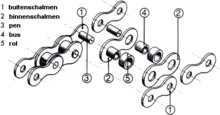- Bicycle chain
-
This article is about the drive chain on a bicycle. For bicycle chain locks, see Bicycle lock.
 Roller chain and sprocket
Roller chain and sprocket
A bicycle chain is a roller chain that transfers power from the pedals to the drive-wheel of a bicycle, thus propelling it. Most bicycle chains are made from plain carbon or alloy steel, but some are nickel-plated to prevent rust, or simply for aesthetics. Nickel also confers a measure of self-lubrication to a chain's moving parts. Nickel is a relatively non-galling metal.
Contents
History
Obsolete chain designs previously used on bicycles included the block chain, the skip-link chain, and the Simpson lever chain. Most modern bicycle chains used with a single chainring and single rear sprocket are conventional industrial bushing chain. Until the 1980s, most derailleur chains were also bushing chains, but today, virtually all derailleur chains are of the "Sedis" bushingless design. Compared to a bushing chain, a bushingless chain is cheaper to make, is less likely to break under shifting load, promotes better lubricant flow inside the rollers, and creates more lateral flexibility for multi-geared bicycles. However, it also wears much faster and has slightly worse mechanical efficiency than a bushing chain.
Before the safety bicycle, bicycles did not have chains and the pedals were typically attached directly to the drive-wheel, thus limiting top speed by the diameter of the wheel and resulting in designs with front wheels as large as possible. Various linkage mechanisms were invented to raise the effective gear ratio, but with limited success. Using chain drive allowed the mechanical advantage between the drive and driven sprockets to determine the maximum speed, thereby enabling manufacturers to reduce the size of the driving wheel for safety. It also allowed for the development of variable gearing, allowing cyclists to adjust their gearing to the difficulty of the terrain, on the fly.
Efficiency
A bicycle chain can be very efficient: one study reported efficiencies as high as 98.6%.[1] The study, performed in a clean laboratory environment, found that efficiency was not greatly affected by the state of lubrication.[1] A larger sprocket will give a more efficient drive, reducing the movement angle of the links. Higher chain tension was found to be more efficient: "This is actually not in the direction you'd expect, based simply on friction".[1]
Maintenance
How best to lubricate a bicycle chain is a commonly debated question among cyclists.[2] Liquid lubricants penetrate to the inside of the links and are not easily displaced, but quickly attract dirt. "Dry" lubricants, often containing wax or Teflon, are transported by an evaporating solvent, and stay cleaner in use. The cardinal rule for long chain life is never to lubricate a dirty chain, as this washes abrasive particles into the rollers.[3] Chains should be cleaned before lubrication. The chain should be wiped dry after the lubricant has had enough time to penetrate the links. An alternative approach is to change the (relatively cheap) chain very frequently; then proper care is less important. Some utility bicycles have fully enclosing chain guards which virtually eliminate chain wear and maintenance. On recumbent bicycles the chain is often run through tubes to prevent it from picking up dirt, and to keep the cyclist's leg free from oil and dirt.
Removal
On most upright bicycles, the chain loops through the right rear triangle made by the right chain stay, right seat stay, and seat tube. Thus a chain must be separated, "broken" is a term commonly used, with a chain tool or at a master link. (Care must be taken not to push the rivet all the way out, as it is very difficult to reinsert. See "Removing a Bicycle Chain" in the Wikibook on bicycles.) A master link, also known as a connecting link, allows the chain to be inserted or removed with simpler tools, or even no tools, for cleaning or replacement.[2]
Some newer chain designs, such as Shimano and Campagnolo 10-speed chains, require a special replacement pin to be used when installing or reinstalling a separated chain. An alternative to this process is to install a master link, such as a SRAM Power Link or a Wippermann Connex.[4]
Wear
Chain wear, or chain stretch, becomes an issue with extensive cycling. Although the overall effect is often called "stretch", chains generally wear through attrition of the bushings (or half-bushings, in the Sedis design) and not by elongation of the sideplates. The tension created by pedaling is insufficient to cause the latter. Because an old chain is longer than needed, its links will not precisely fit the spaces between teeth in the drivetrain, making gear shifts a problem and possibly resulting in a 'skipping' chain that reduces power transfer and makes pedalling very uncomfortable.
Since chain wear is strongly aggravated by dirt getting into the links, the lifetime of a chain depends mostly on how well it is cleaned (and lubricated) and does not depend on the mechanical load.[3] Therefore, well-groomed chains of heavily used racing bicycles will often last much longer than those of a lightly used, but not so well cleaned city bike. Depending on use and cleaning, a chain can last only 1,000 km (e.g. in cross-country use, or all-weather abuse), 3,000 to 5,000 km for well-maintained derailer chains, or more than 6,000 km for perfectly groomed high-quality chains, single-gear, or hub-gear chains (preferably with a full cover chain guard).[5]
Chain wear rates are highly variable, so replacement by calendar is likely to cause either needless chain replacement or continued use of a worn chain, damaging rear sprockets. One way to measure wear is with a ruler. Another is with a chain wear tool, which typically has a "tooth" of about the same size found on a sprocket. They are simply placed on a chain under light load and report a "go/no-go" result - if the tooth drops in all the way, the chain should be replaced.
Twenty half-links in a new chain measure 10" (254 mm), and replacement is recommended before the old chain measures 256 mm (0.7% wear).[2] A safer time to replace a chain is when 24 half-links in the old chain measure 121/16 inches (0.5% wear). If the chain has worn beyond this limit, the rear sprockets are also likely to wear, in extreme cases followed by the front chainrings. In this case, the 'skipping' mentioned above is liable to continue even after the chain is replaced, as the teeth of the sprockets will have become unevenly worn (in extreme cases, hook-shaped). Replacing worn sprocket cassettes and chainrings after missing the chain replacement window is much more expensive than simply replacing a worn chain in the first place.
Sizes
The chain in use on modern bicycles has a 1/2" pitch, which is ANSI standard #40, where the 4 indicates the pitch of the chain in eighths of an inch, and metric #8, where the 8 indicates the pitch in sixteenths of an inch.
Width
Chains comes in either 3/32", 1/8", 5/32" or 3/16" roller widths: 5/32" is used on cargo bikes and trikes, 1/8" with low-cost coaster brake (back pedal) bikes, hub gear and fixed gear bicycles, and on track bikes. (Fixed cogs and freewheels are also available in 3/32" widths; fixed gear and single-speed bikes can be set up to use either 1/8" or 3/32" chains.) Derailleur equipped bikes such as racing, touring and mountain bikes use 3/32" chains exclusively.
The Wikibook, "Bicycle Maintenance and Repair", explains that the difference between derailleur chains commonly labelled 8-speed, 9-speed, and 10-speed is in its external width (all are 3/32" chains, that is, in their minimum internal clearances).
Length
New chains usually come in a stock length, long enough for most upright bike applications. The appropriate number of links must be removed before installation in order for the drive train to function properly. The pin connecting links can be pushed out with a chain tool to shorten, and additional links may be added to lengthen.
In the case of derailleur gears the chain is usually long enough so that it can be shifted onto the largest front chain ring and the largest rear cog without jamming, and not so long that, when shifted onto the smallest front chain ring and the smallest rear cog, the rear derailleur cannot take up all the slack. Meeting both these requirements is only possible if the rear derailleur is compatible with the gear range being used on the bike.
In the case of single-speed bicycles and hub gears, the chain length must match the distance between crank and rear hub and the sizes of the front chain ring and rear cog. These bikes usually have some mechanism for small adjustments such as horizontal dropouts, track ends, or an eccentric mechanism in the rear hub or the bottom bracket. In extreme cases, a chain half-link may be necessary.
Variations
In order to reduce weight, chains have been manufactured with hollow pins and with cut-outs in the links. A few titanium chains have also been made, but while much lighter they are vastly more expensive, perhaps 10x the cost, and the titanium bearing surfaces reportedly wear quickly, leading to shortened life and reduced efficiency.
Manufacturers
Notable bicycle chain manufacturers include:
- Campagnolo
- Rohloff AG
- Shimano
- SRAM
- Wippermann
See also
References
- ^ a b c Spicer, James (1999-08-19). "Pedal Power Probe Shows Bicycles Waste Little Energy". http://www.jhu.edu/news_info/news/home99/aug99/bike.html. Retrieved 2008-02-13.
- ^ a b c "Sheldon Brown: Chain Maintenance". http://www.sheldonbrown.com/chains.html. Retrieved 2008-12-03.
- ^ a b Brandt, Jobst. "Chain care, wear and skipping". http://www.sheldonbrown.com/brandt/chain-care.html. Retrieved 2008-12-03.
- ^ "Sheldon Brown: Chains from Harris Cyclery". http://sheldonbrown.com/harris/chains.html. Retrieved 2008-12-03.
- ^ "KMC: How to minimize chain wear". http://www.kmcchain.com/index.php?ln=en&fn=service#4. Retrieved 2009-05-20.
External links
- Bicycle chain length calculator and stretch/wear test
- Wikibooks Bicycle Maintenance and Repair - see the section on Chains
- The Complete Guide to Chain - general, not specific to bicycles
- How to calculate chain length (video tutorial)
- Animation of Shimano gearing system
List of bicycle parts Frame Handlebars · Stem · Head tube · Headset · Fork · Seatpost · Saddle · Bottom bracket · Dropout · Suspension
Wheels Drivetrain Cabling Peripherals Basket · Bell · Bottle cage · Fairing · Cyclocomputer · Kickstand · Lighting · Luggage carrier · Mudguards · Pannier · Saddlebag · Reflectors · Skirt guard · Training wheelsCategories:- Chain drives
- Bicycle parts
- Mechanical power transmission
- Mechanical power control
Wikimedia Foundation. 2010.



